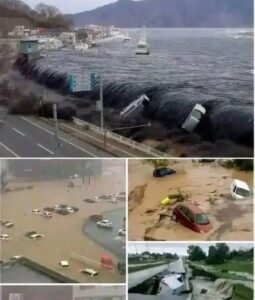Breaking: Massive 8.2 Magnitude Earthquake Strikes Alaskan Peninsula — Tsunami Alerts Issued Across Pacific

A massive earthquake struck off the Alaskan Peninsula late Wednesday night, shaking the region and triggering widespread tsunami alerts across the Pacific. The U.S. Geological Survey (USGS) recorded the quake at a powerful 8.2 magnitude, making it one of the strongest seismic events in the region in recent years.
The earthquake’s epicenter was located approximately 91 kilometers (56 miles) east-southeast of Perryville, Alaska, and occurred at a depth of 35 kilometers (22 miles) beneath the Earth’s surface. The shaking was felt throughout southern Alaska, sending residents into panic as tsunami sirens blared along coastal towns.
Tsunami Warnings and Emergency Response
The U.S. National Tsunami Warning Center (NTWC) immediately issued tsunami warnings for large portions of southern Alaska, stretching from Hinchinbrook Entrance to Unimak Pass. Videos posted to social media and verified by Reuters captured the chilling sound of tsunami sirens echoing in towns like Kodiak, where residents scrambled to higher ground as a precaution.
Emergency officials across the region activated evacuation plans, with many communities moving swiftly to safeguard vulnerable coastal populations. In Kodiak, emergency shelters were opened, and residents were urged to bring essential items and stay away from shorelines.
The Pacific Tsunami Warning Center also issued advisories for other parts of the Pacific, including Hawaii and Guam, though both regions were later declared safe after initial modeling showed no significant threat of destructive waves. However, Japan, New Zealand, and other Pacific nations began independent assessments in coordination with U.S. and global seismic monitoring systems.
Alaska Mobilizes Emergency Operations
Alaska Governor Mike Dunleavy confirmed in a late-night briefing that the state had activated its Emergency Operations Center (EOC) to coordinate responses with local, state, and federal agencies. “While no immediate casualties or damages have been reported, we are not taking any chances,” Dunleavy said. “Our teams are actively monitoring coastal infrastructure and transportation routes.”

Aftershocks and Ongoing Monitoring
The USGS has confirmed that at least eight aftershocks followed the initial quake, including two that registered magnitudes above 6.0, adding to the region’s anxiety. Seismologists warn that additional aftershocks are likely in the coming hours and days, some potentially strong enough to be felt.
Residents have been advised to remain alert, follow evacuation protocols if instructed, and report any structural damage or injuries to local emergency services.
A Region All Too Familiar with Seismic Activity
The Alaskan Peninsula lies within the Ring of Fire, a seismically active zone that encircles the Pacific Ocean and is responsible for 90% of the world’s earthquakes. Alaska itself is no stranger to major tremors—most notably the 1964 Good Friday Earthquake, which measured 9.2 in magnitude and remains the most powerful earthquake ever recorded in North America.
This latest quake, while not as devastating, is a sobering reminder of the geological forces that shape the region and the critical importance of preparedness.
What’s Next?
Geologists and tsunami scientists are continuing to analyze seismic data to determine the full impact and any additional risk to coastal communities. For now, authorities are urging calm but caution as the situation develops.
Citizens are encouraged to stay tuned to official weather and emergency services, avoid spreading unverified information on social media, and take every warning seriously—even if visible damage appears minimal.
This is a developing story. Updates will follow as more information becomes available.